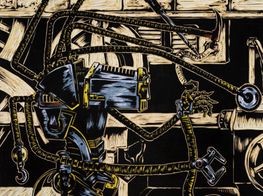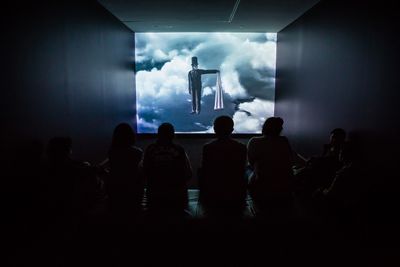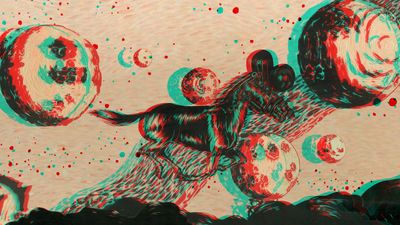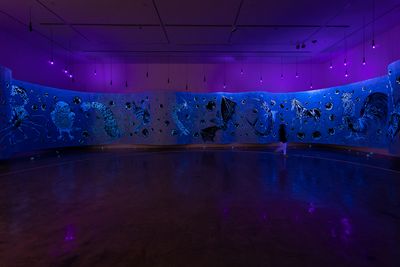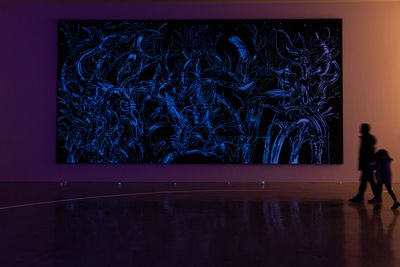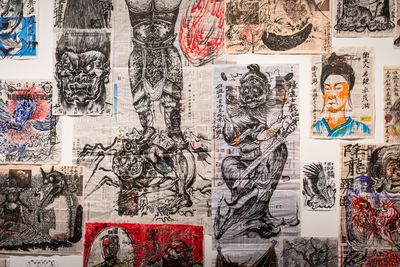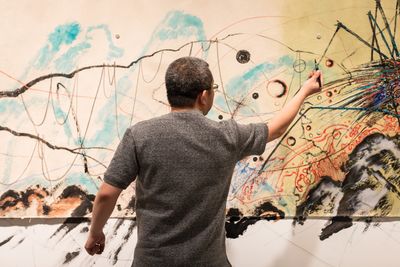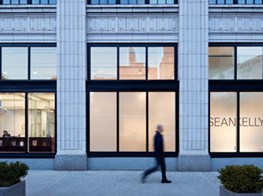Sun Xun: Time-Lapse Stories
Sun Xun. Courtesy the artist and Edouard Malingue Gallery, Hong Kong. © Sun Xun.
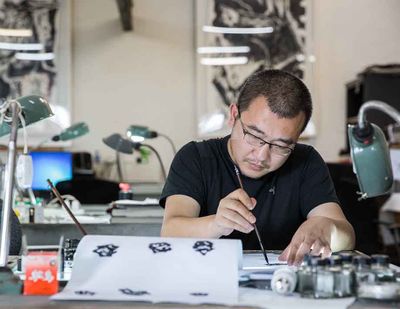
Sun Xun. Courtesy the artist and Edouard Malingue Gallery, Hong Kong. © Sun Xun.
Born in 1980 in Fuxin, China, to a factory-worker and military family, Sun Xun's father advised him to avoid politics. He was encouraged by his family to move to Hangzhou at the age of 16 to pursue his studies as an artist at a high school affiliated with the China Academy of Fine Arts.
It was at CAFA that the artist honed his aesthetic and conceptual approach to storytelling. Despite a long-standing interest in film, Sun Xun could not afford a camera as a student, so he began to narrate stories by making hundreds of woodblock prints, which he would then use to create distinctive, labour-intensive animations. Sun Xun's five-minute-long animation, Shock of Time (2006) is distinctive of this style. This work considers the role of time in relation to our day-to-day lives through the journey of a cloaked man who walks across the surface of many pages of text-based information and documents, where the pages become his background.
Sun Xun often incorporates film into immersive installations, such as Mythological Time (2016)—included in the group exhibition Tales of Our Time (4 November 2016–10 March 2017) at the Guggenheim Museum in New York. This animated film ruminates on the artist's hometown Fuxin in northeastern China, and the relationship between the town and its once-thriving coal industry. Focusing in on the workers, the film presents a loose narrative between their livelihoods and the wider connection to the environmental degradation caused by the industry. The film is projected onto thick, traditional Chinese paper, which covers the surrounding walls, creating a different surface texture. Ink drawings on the paper depict some of the motifs and backgrounds from the film itself, such as an old knobby tree, a bird, and figures of men.
Conceptually, Sun Xun is interested in the multiplicities present at any given time, and resists singular narratives or linear story-telling structures. The New China (2008) is a video and site-specific installation that was exhibited at the Hammer Museum in 2008; it uses allegory to question ideas around nationhood through a variety of different motifs, including the top-hatted man who appears in other works by the artist, and mosquitos that the artist uses as representation of parasitic carriers of information and control. These different characters are presented in a larger installation that could be described as a mise-en-scène of the film itself; offering up excerpts and motifs from the film; and spilling these out to a larger installation format. As the artist notes, 'Most people look at history like a performance on a stage. They don't look behind the curtains to see what is really happening'.1 Thus, he restages history as a surreal play, where symbols and their associations perform like puppets in a theatre.
In this conversation, Sun Xun discusses his world-travelled practice and the opening of his first major solo exhibition in Australia at the Museum of Contemporary Art Australia (MCA), curated by Anna Davis (9 July–14 October 2018).
TMYou grew up in Fuxin, a town in the province of Liaoning in northeast China, which was well-known for coal mining.
SXYes, it's in the northeast part of China between Mongolia and North Korea. Fuxin is my hometown; and it is where the largest open-cut coal mine in Asia was once located. It used to be a powerful city that produced a lot of coal, and as a result it was also very noisy and dirty, but rich. Now, as has been the case with international cities such as Detroit in the U.S., there has been an economic downturn due to the lack of industry. Fuxin is in a very poor area of China, and it has become a difficult place to live and survive for locals.
TMCan you tell me more about your schooling?
SXWhen I was a child I first studied in my hometown, Fuxin. Then, when I was 16, I moved to Hangzhou, a very beautiful city near Shanghai, to study. After that, I continued to study art at the China Academy of Art, and stayed in Hangzhou for 13 years altogether. Following my time at the China Academy I moved to Beijing, where I am still based today.
TMWhen did you decide to become an artist?
SXIt was after I finished studying at university that I truly felt like I had become an artist, because I had developed a strong sense of my work. The work I was making was more mature than what I had been making as a student. By the time I graduated, I had already completed seven animation films and participated in some exhibitions, but I feel like I became a 'real artist' only after my studies.
TMI understand that you often use woodcuts both as a material but also as a conceptual point of departure in your practice, taking into account the presence of woodcut techniques in art history. How does this process feed into your practice today?
SXMy working system is my enemy—I have to challenge it by trying new materials, and new ways of making. If you always stay in your prison, you will do nothing, and you will die in that prison. My whole oeuvre is my prison, and I have to struggle in that prison to challenge it and never stop, which is why I do woodcut work, and also why I started my first feature film, which has not yet been completed.
TMTalking about new ideas, your show at MCA Australia is your first major solo exhibition in Australia. What are you hoping to explore or express here?
SXThis exhibition will imagine a parallel world. I was inspired in a way by Australia—being a big island country, that feels separate to the rest of the world. I wish to draw from this analogy when thinking about a parallel universe. So, for this solo exhibition I'm making totally new work; I want to make the most of the huge space at MCA. It's work that makes me very excited because I don't know what the end result will be.
The animation work is called Maniac Universe (2018) and is an enormous painting, over 40 metres in length, painted on handmade mulberry bark paper, talking about a parallel world as a metaphor or analogy to try and make us understand that there is always more than one thing happening at one time, and that there is always more than one opinion in circulation. I personally believe that an artist's job is not to make artwork for the present, an artist's job is to make work for the future. I also think the artist's job is to go beyond aesthetics, and use the work as a door to open people's minds.
My animation films are sometimes about politicians, monuments, history, time and space. To put different elements together is good art. My work is about the human view on the world; and it is about getting people to try to gain perspective.
TMCould you tell us more about the works you are showing?
SXI have mixed new and old work, making traditional-style screens just for the show, and I will also show some older animation films—I really had no time to make a long animation film for this exhibition. But the old work for Australia is also new work in a way, because I've never shown such long animation films in Australia before. I made a new collection of my animations, connecting different ideas together, and some of these will be displayed in a loop on level one of MCA. I am showing Who First Saw the Stars? (2018), which consists of 25 woodcut paintings made with glow-in-the-dark pigment that together create a single botanical image, lit by ultraviolet light in the gallery.
TMAnna Davis, the exhibition curator, mentioned that part of your exhibition will include a 'live-residency' of sorts. Could you talk about that?
SXThe method and process of work is another important part of my practice. In my way, I want to bring the idea outside of the studio. My plan is to go to Sydney and talk with local people, taking care of the local culture and background, in order to get new ideas from being responsive in the moment. I can't say much at the moment, because I will need to consider the local context first. I think I will know more about what I will do after I arrive in Sydney.
TMHow do you think audiences in Sydney will respond to your work?
SXI think if viewers manage to enter a new world, or obtain a new vision of the world, then I think I will have succeeded.
TMWhat comes after the MCA for you? Are you working on anything new?
SXThe plan is to complete my first feature film. The run time is 90 minutes. It's another crazy project. I want to put the whole world—including a lot of ideas about art—inside. The film includes detailed materials, drawings, and paintings, which all touch on issues happening in the world right now, looking at international politics, current events—history in the making. The work is a mix of different things together, drawing from traditions from both the eastern and western worlds.
TMIn that way you're like a curator, or a DJ.
SXI believe so.
TMIt is apparent that there is a lot of labour that goes into making your work. How does your studio work?
SXI have a team of about ten people working with me in my studio in Beijing. It is a big studio because my main line of work is animation, which is quite laborious, and I need a team to help me. If only one person works on it at a time, it takes far too long, and it is too much work for me to do by myself. The team operates just like a normal animation company: each person has a different job that contributes towards the overall work.
TMWhen things get too busy at the studio, do you have somewhere that you retreat to?
SXYes, I like to retreat to the mountains. They are far away from my studio and things exist there at a different pace, and I really like that. I do this in China, and I also make it a practice when I travel to visit nature by myself. To leave human culture behind helps me generate new ideas—by opening my mind to where I am, I forget the world that I came from.
It's like going to a natural church, where there is only you and God, nobody else. Then you can talk with God and God will guide you on what you should do. You just have to look inside your spirit. I think that's very important for artists.—[O]
1 https://www.mca.com.au/stories-and-ideas/sun-xuns-parallel-worlds/
The writer would like to thank Cindy Cen for her translation assistance.

